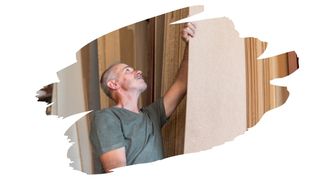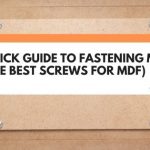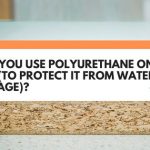We now have a wide range of fantastic wood sealants nowadays.
And it’s never been easier to finish and protect solid natural timber from water damage. Gone are the days when your only sealing options were a handful of oil finishes, such as Linseed oil or Tung oil.
Related Post: Can You Use Linseed Oil On MDF? (What You Need To Know) | The Woodwork Place
However, MDF (also known as medium density fiberboard), isn’t a natural material. Rather, this specially engineered board is a wood composite.
Packed with hardwood shavings, (all held together with adhesive), MDF can be fairly tricky to seal up tight. Which is a big problem if you want to use MDF boards for an outdoor structure.
So, what can you do to protect this easily water-damaged material?
Well, in this post, you will learn whether you should be using MDF (for an outdoor project) in the first place. And we reveal the very best sealant for MDF boards (hint: this stuff is used to seal sea-worthy boats and rain-drenched decking).

This post may contain affiliate links to products that we receive a commission for (at no additional cost to you). Learn more here.
So, Is MDF Really OK For Exterior Use?
If you are using a standard piece of MDF board, then no, it is not.
MDF is one of the most easily water damaged materials you could ever hope to work with. And when it’s used for interior items, (such as kitchen countertops), it needs to be sealed to prevent water from soaking into it.
Without that waterproofing sealant, MDF will swell, warp and bow right out of position. Which is why standard MDF won’t last long outside, especially in high humidity and/or rainy climates.
This is why MDF tends to be better for indoor uses like cabinets and interior doors.
It’s not the most moisture-resistant material. But if you can keep an MDF door nice and dry, like in a bedroom or office – not a high humidity spot like the bathroom – it’ll actually hold up pretty well for over 10 years.
The key is avoiding moisture absorption, which can make MDF swell up and deteriorate faster. But with the right placement, MDF can be a budget-friendly choice for some interior projects.
If you want to learn more about using it for interior doors specifically, just check out our post here: A Quick Guide To MDF Interior Doors (Top 3 Pros And Cons)
OK, Then How Do You Protect MDF Outside?
The only type of MDF worth using on outdoor structures is Exterior-Grade MDF.
This rather expensive type of medium density fiberboard isn’t waterproof. However, it is very moisture-resistant, much more so than standard MDF.
So, what this means is that, exterior-grade MDF is less likely to bow and warp due to humidity. Still, it will need to be sealed up tight (just like standard MDF) if it is to survive the great outdoors.
But, What Exactly Is Exterior Grade MDF?
It’s a special kind of medium density fiberboard, one that has a lot more wood shavings packed tightly into it. Those extra shavings make this version of MDF more durable than it’s standard MDF counterpart.
Also, because exterior-grade MDF is moisture resistant, it doesn’t succumb to rot and decay easily. Which is a good thing when it comes exterior structures, because that lack of rot doesn’t leave any mulch for insects and bugs to bore into.
So, Is Exterior MDF Board Waterproof?
Not quite. Exterior-grade MDF is moisture resistant but not completely waterproof.
While it stands up well to moisture and humidity, it still needs additional protection from direct contact with liquid water. So, while it won’t easily rot or decay, exterior MDF still needs protection from direct contact with rain and moisture.
Can’t You Simply Make Standard (Or Exterior-Grade) MDF Waterproof?
The only way to waterproof MDF would be to wrap it in a completely airtight seal.
That’s because waterproofing would mean that nothing, not water droplets, moisture, or even water vapour could get past a waterproof sealer. And this is not easy to do with MDF, (especially what with all of it’s exposed edges).
Instead your best bet is to focus on making MDF boards as water-resistant as possible. And the way to do this is by coating it with a solvent-based waterproofing finish, sealant or paint.
And How Does MDF Hold Up To Moisture (Once It’s Been Sealed)?
Provided you take the time to really seal it’s open ends with a watertight finish, finished MDF can be pretty moisture-resistant.
But, that’s provided you use a solvent-based sealer, and not a water-based one.
You see, MDF is so absorbent, its been known to wick up the very water-content of a water-based finish…well before that finish has had time to set.
Can You Waterproof MDF With PVA Carpentry Glue? PVA glue is a water-based adhesive. Applying this onto MDF won’t seal it, because MDF will soak up PVA glues water-content before it can set properly.
So What Can You Use To Seal MDF And Waterproof It?
The best way to seal MDF boards is by using a urethane-based sealant.
These solvent-based finishes won’t let moisture or water droplets get past them. That’s because urethane, (the key ingredient in a polyurethane finish), is one of the most water-resistant wood finishes out there.
And unlike other sealers, this stuff won’t even let water vapour seep through it either. Which is key to keeping moisture-wicking MDF perfectly dry.
Even a time-honoured outdoor sealant, such as Tung oil wouldn’t be enough of an MDF sealant.
Now, we all know Tung oil is a classic natural sealant for wood. But unfortunately it’s not enough to properly seal and protect MDF if it’s going to be outdoors.
The oil will soak into the wood fibers, which does help reduce water absorption a bit. And it leaves a hard resin surface that can handle small spills and moisture. But when compared to urethane sealants, Tung oil just can’t provide the same level of water protection that MDF would need for long-term outdoor use.
Urethane sealers form a much more impenetrable moisture barrier. And if you want to dive deeper into how Tung oil performs specifically on MDF, have a read through out post here: Can You Use Tung Oil On MDF?
OK, And What Kind Of Urethane Finish Can You Seal MDF With?
You should use Spar Urethane to wrap up that MDF surface.
This finish, (also known as Spar Varnish), has been used to waterproof boats and outdoor decking. And it will easily waterproof MDF as well.
What’s more, a good quality Spar Urethane finish will include UV-inhibitors and fungicides. And these two additional ingredients allow Spar Urethane to protect MDF from UV damage, mold and mildew.
To Wrap Up, Here Are The 3 Key Takeaways From This Post…
- 1). Standard MDF is much too easily water-damaged to ever be used outdoors.
- 2). Even Exterior-grade MDF, (a more moisture-resistant version of standard MDF), will absorb water if it is not properly sealed.
- 3). If you want to waterproof MDF, coat it in Spar Urethane (also known as Spar Varnish). And take extra care to seal over any exposed ends and edges.
References:
Yang, Han-Seung, et al. “Water absorption behavior and mechanical properties of lignocellulosic filler–polyolefin bio-composites.” Composite structures 72.4 (2006): 429-437.



